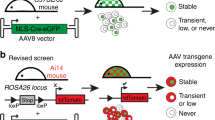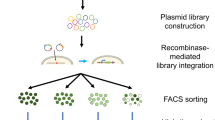Abstract
We describe here a clonal approach for efficient and robust construction of recombinant adenoviral genomes that holds certain advantages over existing approaches. Transgenes of interest are cloned into a small, conditionally replicating plasmid containing the left end of a recombinant adenoviral genome, encompassing pIX coding regions. Transformation of this plasmid into recombination-competent Escherichia coli bearing a plasmid containing the right end of a recombinant adenoviral genome, commencing from pIX coding regions, yields a stable co-integrated plasmid encoding a full adenoviral genome, by virtue of shared homology in pIX coding regions contained in both plasmids. The recombination process yielding the full adenoviral plasmid requires only one step, and always results in the formation of only the desired recombinant adenoviral genome. Thus, no screening is required to identify the correct plasmid encoding the desired recombinant adenoviral genome. In addition, the plasmid encoding the right-hand side of the adenoviral genome is itself incapable of producing contaminating adenovirus. We have successfully employed this approach to generate over 200 recombinant adenoviruses, obtaining only the desired recombinant adenoviral species each time. The process is amenable to medium-to-high-throughput parallel construction of adenoviral genomes, and as such should aid efforts aimed towards high-throughput functional annotation of therapeutic gene targets, which aim to leverage the benefits of adenoviruses as gene delivery and expression vectors.
This is a preview of subscription content, access via your institution
Access options
Subscribe to this journal
Receive 12 print issues and online access
$259.00 per year
only $21.58 per issue
Buy this article
- Purchase on Springer Link
- Instant access to full article PDF
Prices may be subject to local taxes which are calculated during checkout



Similar content being viewed by others
References
Russell WC . Update on adenovirus and its vectors. J Gen Virol 2000; 81: 2573–2604.
Xia H, Mao Q, Paulson HL, Davidson BL . siRNA-mediated gene silencing in vitro and in vivo. Nat Biotech 2002; 20: 1006–1010.
Arts G-J et al. Adenoviral vectors expressing siRNAs for discovery and validation of gene function. Genome Res 2003; 13: 2325–2332.
Miyake S et al. Efficient generation of recombinant adenoviruses using adenovirus DNA-terminal protein complex and a cosmid bearing the full-length virus genome. Proc Natl Acad Sci USA 1996; 93: 1320–1324.
Mizuguchi H, Kay MA . Efficient construction of a recombinant adenovirus vector by an improved in vitro ligation method. Hum Gene Ther 1998; 9: 2577–2583.
Moraes MP, Mayr GA, Grubman MJ . pAd5-Blue: direct ligation system for engineering recombinant adenovirus constructs. BioTechniques 2001; 31: 1050–1056.
Gao G et al. High throughput creation of recombinant adenovirus vectors by direct cloning, green–white selection and I-Sce I-mediated rescue of circular adenovirus plasmids in 293 cells. Gene Therapy 2003; 10: 1926–1930.
McVey D, Zuber M, Brough DE, Kovesdi I . Adenovirus vector library: an approach to the discovery of gene and protein function. J Gen Virol 2003; 84: 3417–3422.
Chartier C et al. Efficient generation of recombinant adenovirus vectors by homologous recombination in Escherichia coli. J Virol 1996; 70: 4805–4810.
Crouzet J et al. Recombinational construction in Escherichia coli of infectious adenoviral genomes. Proc Natl Acad Sci USA 1997; 94: 1414–1419.
He T-C et al. A simplified system for generating recombinant adenoviruses. Proc Natl Acad Sci USA 1998; 95: 2509–2514.
Bett AJ, Haddara W, Prevec L, Graham FL . An efficient and flexible system for construction of adenovirus vectors with insertions or deletions in early regions 1 and 3. Proc Natl Acad Sci USA 1994; 91: 8802–8806.
Hardy S et al. Construction of adenovirus vectors through Cre–lox recombination. J Virol 1997; 71: 1842–1849.
Michiels F et al. Arrayed adenoviral expression libraries for functional screening. Nat Biotech 2002; 20: 1154–1157.
Elahi SM et al. Adenovirus-based libraries: efficient generation of recombinant adenovirus by positive selection with the adenovirus protease. Gene Therapy 2002; 9: 1238–1246.
Hatanaka K et al. A simple and efficient method for constructing an adenoviral cDNA expression library. Mol Ther 2003; 8: 158–166.
Ketner G et al. Efficient manipulation of the human adenovirus genome as an infectious yeast artificial chromosome clone. Proc Natl Acad Sci USA 1994; 91: 6186–6190.
Hokanson CA et al. Hybrid yeast–bacteria cloning system used to capture and modify adenoviral and nonviral genomes. Hum Gene Therapy 2003; 14: 329–339.
Fallaux FJ et al. New helper cells and matched early region 1-deleted adenovirus vectors prevent generation of replication-competent adenoviruses. Hum Gene Ther 1998; 9: 1909–1917.
Davison AJ, Benko M, Harrach B . Genetic content and evolution of adenoviruses. J Gen Virol 2003; 84: 2895–2908; (GenBank accession number for human Ad5 is BK000408).
Stalker DM, Kolter R, Helinski DR . Plasmid R6K DNA replication. I. Complete nucleotide sequence of an autonomously replicating segment. J Mol Biol 1982; 161: 33–43.
Filutowicz M, Rakowski SA . Regulatory implications of protein assemblies at the gamma origin of plasmid R6K – a review. Gene 1998; 223: 195–204.
Robert JJ et al. Degnerated pIX-IVa2 adenoviral vector sequences lowers reacquisition of the E1 genes during virus amplification in 293 cells. Gene Therapy 2001; 8: 1713–1720.
Yeh P et al. Efficient dual trans-complementation of adenovirus E1 and E4 regions from a 293-derived cell line expressing a minimal E4-functional unit. J Virol 1996; 70: 559–565.
Dedieu JF et al. Long-term gene delivery into the livers of immunocompetent mice with E1/E4-defective adenoviruses. J Virol 1997; 71: 4626–4637.
Louis N, Evelegh C, Graham FL . Cloning and sequencing of the cellular-viral junctions from the human adenovirus type 5 transformed 293 cell line. Virology 1997; 233: 423–429.
Blanche F et al. An improved anion-exchange HPLC method for the detection and purification of adenoviral particles. Gene Therapy 2000; 12: 1055–1062.
Vigne E et al. Genetic manipulations of adenovirus type 5 fiber resulting in liver tropism attenuation. Gene Therapy 2003; 10: 153–162.
Sambrook J, Russell DW . Molecular Cloning: A Laboratory Manual. CSHL Press: New York, 2001.
Bloomfield IC, Vaughn V, Rest RF, Eisenstein BI . Allelic exchange in Escherichia coli using the Bacillus subtilis sacB gene and a temperature-sensitive pSC101 replicon. Mol Microbiol 1991; 5: 1447–1457.
Gay P et al. Positive selection procedure for entrapment of insertion sequence elements in gram-negative bacteria. J Bacteriol 1985; 164: 918–921.
Oka A, Sugisaki H, Takanami M . Nucleotide sequence of the kanamycin resistance transposon Tn903. J Mol Biol 1981; 147: 217–226.
Grindley ND, Joyce CM . Analysis of the structure and function of the kanamycin-resistance transposon Tn903. Cold Spring Harb Symp Quant Biol 1981; 45: 125–133.
Acknowledgements
We gratefully acknowledge the support of the Centre National de la Recherche Scientifique and the European Union Marie Curie Fellowship Programme in carrying out this study. We are also grateful to Patrice Yeh for reviewing the manuscript prior to submission.
Author information
Authors and Affiliations
Rights and permissions
About this article
Cite this article
Mullan, B., Dugué, C., Moutard, V. et al. Robust functional gene validation by adenoviral vectors: one-step Escherichia coli-Derived Recombinant Adenoviral Genome construction. Gene Ther 11, 1599–1605 (2004). https://doi.org/10.1038/sj.gt.3302333
Received:
Accepted:
Published:
Issue Date:
DOI: https://doi.org/10.1038/sj.gt.3302333
Keywords
This article is cited by
-
A gene transfer comparative study of HSA-conjugated antiangiogenic factors in a transgenic mouse model of metastatic ocular cancer
Cancer Gene Therapy (2007)
-
Adenovirus-mediated herpes simplex virus thymidine kinase gene transfer driver by KDR promoter in treatment of experimental human hepatocelLular carcinoma in nude mice
Chinese Journal of Cancer Research (2007)



